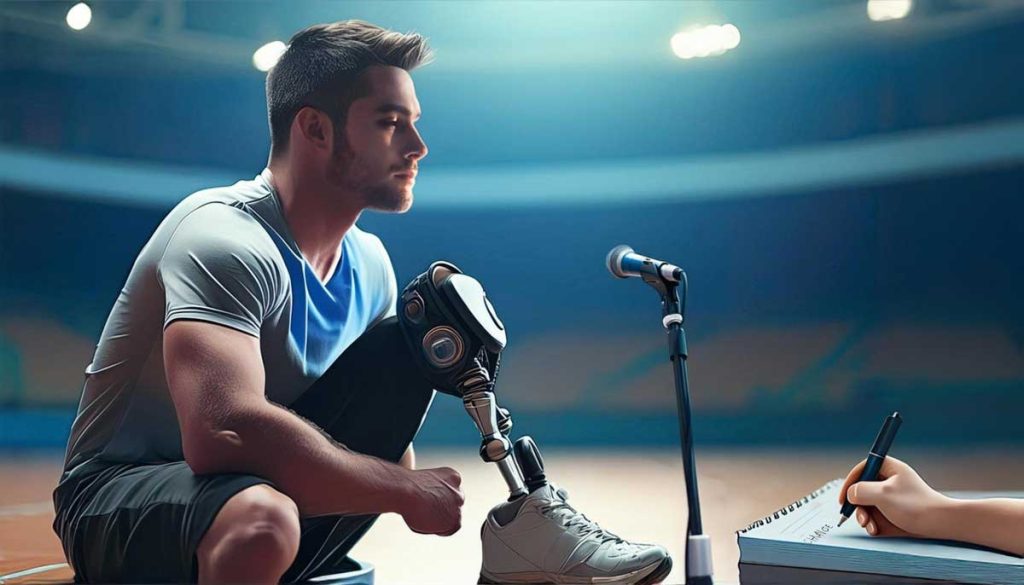Semi-finalist 2024
| Submitted by: | Mayank Rehani |
| Department: | Medicine |
| Faculty: | Medicine & Dentistry |
This image captures a moment during a qualitative interview of a young man, a user of advanced lower-limb prosthesis, as he shares his narrative sitting in an empty sports arena. He is pensive, perhaps reflecting on the life he lived before or a life he has chosen now. As he narrates, a researcher takes notes. The microphone and notebook serve as symbols of the qualitative interview, while the researcher’s handwritten notes convey their active engagement in the lived experience being shared.
Studying lived experiences holds profound value in understanding the complexities of human existence as it offers invaluable insights into human emotion, resilience, and adaptation. My doctoral research explores changes in health-related quality of life of persons with lower-limb amputation who use sophisticated prosthetic devices. By delving into personal narratives, I’ve gained a deeper appreciation for the nuanced realities these persons navigate daily. By listening to patient narratives, healthcare practitioners can tailor their approaches to better meet their diverse needs, fostering effective communication, trust, and collaboration for improved health outcomes and patient satisfaction.
Was your image created using Generative AI?
Yes.
Which model of generative AI did you use?
Adobe Firefly.
How was your image created?
Using Adobe Firefly, I started with the following prompt: “Young man with one above-knee amputation and a bone-anchored prosthesis, the left side of face visible, looking to the right, hyper realistic, art, cinematic.” Firefly generated four images based on the prompt, and I chose the image of this young man as his expression matched most closely with what I was hoping to convey. I clicked on this image and selected ‘Edit’ > ‘Generative fill (preview)’. Using generative fill, I expanded the image horizontally using the ‘Expand’ option and moved the image of the young man slightly to the left. In the extended portion of the image on the right, I inserted a microphone using the ‘Insert’ option and selecting ‘Add’, in front of the man’s left shoe by providing the prompt “microphone, hyper realistic.” I chose one of three options that I deemed to look most appropriate. Next, I used the ‘Insert’ option again and selected ‘Add’ to add a notepad, pen, and hand to the right of the microphone using the following prompt: “notepad and a hand writing the word ‘change’ in the notepad, hyper realistic, art, cinematic” and I chose one of three options that I deemed most consistent with the image.
How did you craft your prompt to guide the generative AI in creating your image? Please describe the technique or approach you used to convey your vision to the AI.
Using Adobe Firefly, I started with the following prompt: “Young man with one above-knee amputation and a bone-anchored prosthesis, the left side of face visible, looking to the right, hyper realistic, art, cinematic.” After selecting one of four images generated, I added the microphone, notepad, and the hand writing notes using the ‘Generative fill (preview)’ option. The prompts I used were “microphone, hyper realistic” and “notepad and a hand writing the word ‘change’ in the notepad, hyper realistic, art, cinematic.” Each time, I chose one of three options that I deemed to look most appropriate. My technique was to use details in my prompts to convey how I wanted to subject of the image to look and where should he be looking. I started with smaller, simpler prompts and then built a longer initial prompt by adding or deleting words and prepositions that seemed to work. The cinematic prompt generated an empty sports arena and I selected it.

